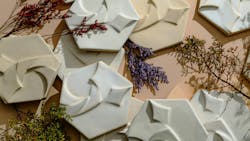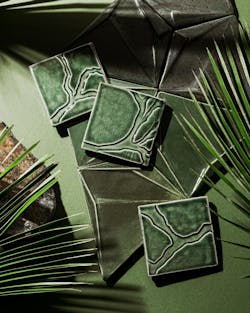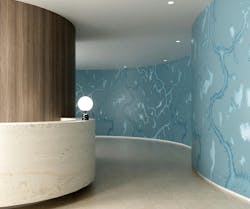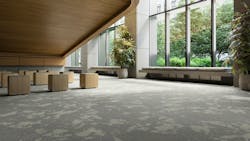Nature's Geometry: The Impact of Fractals on Human Well-being
With nearly 30 years of experience—much of it based in Los Angeles—architect and designer Andrea Keller is no stranger to the ebb and flow of trends and technologies that impact the built environment. However, she finds that many trends have shifted design too far from the core purpose of improving the human condition, by minimizing our connection with the natural exterior world.
“Something was missing, and I ended up feeling that we just needed more nature inside in a very visceral way,” Keller told i+s in a recent podcast episode of I Hear Design.
That sense of longing for nature led her to investigate ways to foster environments that ground occupants the way being outdoors does. But first she needed to learn how people respond to their space subconsciously, and why. As a result of exploring the geometric concept of fractals, their role in biomimicry, and their positive impacts on human well-being, Keller began working with ceramic tile in a more hands-on way with the launch of Star Tile, a custom, three-dimensional tile boutique and showroom, alongside partner Mikayla Mitchell. (See “Fractals: Where Science Meets Surface” below for more fractal design product details.)
Keller shared what she learned about fractals and how they can enhance projects without diluting designers’ creativity.
i+s: Can you talk a little bit about what fractals are and why they have such significance in design? How do they impact neurobiology and wellness?
Andrea Keller: Fractals are geometries that are self-similar at multiple scales. So one example might be branching: You can imagine the branch of a tree that gets smaller and smaller and smaller, but that branching pattern is consistent at multiple scales.
This also happens in a Fibonacci spiral, which we’re familiar with in sunflowers and in the nautilus. The reason that these things are resonant with us is they are also found within us. We see a branching tree—our neurological system branches in the exact same way [and the] same for our cardiovascular and respiratory systems.
When you use fractals in your design, your subconscious is going from a sympathetic to a parasympathetic response. You are leaving fight or flight and you are calming down; that work is all done subconsciously.
Let’s expand what constitutes design, if we can. I want design to do more heavy lifting. There are a lot of confused and unhappy people in this world. And to the extent that we can help heal people or make them feel good, why wouldn't we die on that hill? I mean, I will, anyway!
i+s: In thinking about this conversation and doing some research, there are terms that we read about like biophilic and biomimetic design. Can you talk about the key differences between those and how they intersect in the work that you’re doing?
AK: Biophilia means a love [of nature]. So loving nature is not the same as mimicking it. Biophilia could just be appreciation of it.
While it’s wonderful to have photos of nature, there is a core structure of the oak tree—to go back to that example that we shared. If you send me a picture of the oak tree, there are things that aren’t similar. I have fingers, but [the tree] has these specific leaves, right?
Going to the principles that organize the oak tree, that also organized me, we’re interested in the higher fractal of what’s happening mathematically. When we tap into those, we are doing biomimetic design and we are mimicking nature’s principles rather than just loving it from afar.
i+s: Can you give us an example where you’ve integrated some of these natural geometries, and were there measurable outcomes for the users?
AK: As you know, from the planning stage to completion [of a project] could be four years depending on the jurisdiction. We ended up starting a ceramic tile company; the tile is all based in fractal geometry. Now thousands of these tiles have gone out around the world. What I can say is they are so grounding. The reaction that people typically have—these are three-dimensional tiles […] and I know that there’s nothing like them on the planet. People put their hands on it, they put their face on it. People are “petting” the walls to understand it, and I’ve never petted subway tiles!
People start to have a personal relationship with it. Our experience in the studio and from other installations is it calms you down, it makes you feel good; we hear this again and again.
i+s: One of the other things that you emphasize is this link between neuroscience and design. What are some insights from neuroscience that you use to inform your approach to design?
AK: We have tons of college studies that show that even the observance of fractals, say, in a Jackson Pollock painting—which is kind of inherently fractal because he was using his same arm to make these forms—stimulates very specific lobes in the back of our brain. When these things become activated, our panic drops.
[Fractals] have been shown to reduce stress up to 67%. This is the same research that the Mohawk work is built on; it excited me. But who’s taking this to the next level? How do we get this everywhere?
i+s: Yes, how can architects and designers start to incorporate these types of principles into their projects across diverse environments like workplaces, healthcare facilities, and schools?
AK: Every project can have its own approach, but the key is not to leave this element out. What is fun about fractals is that they can be applied at any scale, whether it’s in the carpet, the lighting, the art, a little motif, the tile. It can be in the smallest thing and it’s a little game.
This isn’t meant to take away from anyone’s design process or style; it’s meant to be an extra tool. So the game would be how they incorporate it while making it their own voice. We are not interested in changing anyone’s voice. We want people to be truly, uniquely themselves. But how can you sneak it in? And what matters is that you do sneak it in.
And [research has] already proven with basic biophilia—just through lighting and bringing in plants and a natural color palette—that it massively increases ROI. People are more creative, they feel more confident, and productivity is usually up 15 or 20 percent even with basic biophilia. That’s not even applying the fractals! So we could really transform things.
i+s: What are the challenges that designers face when they’re trying to integrate some of these principles into projects?
AK: One is availability of products: There are relatively few products on the market. Another is just awareness. Demand creates supply. So, to the extent that designers and architects become aware of [fractal-based design] and demand it, we will see a rise in available products. Then I guess learning how to use it and folding it into an existing design routine. Hopefully that process of integration is fun.
*Interview has been edited and condensed for clarity and length.
Fractals: Where Science Meets Surface
As the concept of biophilia, neuroaesthetics, and the broader wellness trend continue to make inroads in the world of commercial interiors, another intriguing design concept is emerging that is set to support and enhance the ways in which space can support human wellbeing. Fractals, defined as a self-repeating pattern found in nature, are being utilized in product design to tap into the human psyche, promising a number of benefits like stress reduction and cognitive enhancement.
Momentum Textiles & Wallcovering recently launched its Renaturation collection, created as a collaboration between European design firm 13&9 Design and physicist Dr. Richard Taylor. The collection includes wallcoverings like Fractal River, Fractal Moss, and Fractal Bark, and leverages fractal geometry with a “D value” of 1.7, which research suggests aligns with nature’s optimal range (1.3–1.7) for promoting well-being. Going beyond aesthetics, these patterns have been calibrated to reduce stress levels by up to 60% within seconds of exposure, making them ideal for healthcare, hospitality, and workplace environments.
Likewise, carpet manufacturer Mohawk Group recently debuted a fractal-based line under the Relaxing Floors collection, which was also informed by Dr. Taylor’s research. These patterns mimic nature’s complexity and have been shown to positively influence occupants’ physiological states. For example, at the 2024 NeoCon show, the carpets on display in the showroom helped to reduce stress by up to 29% among attendees and staff, which suggests the product may boost wellness in high-traffic commercial interiors.
On a related note, at NeoCon 2025 Dr. Taylor and ScienceDesignLab colleagues Anastasija Lesjak and Martin Lesjak will present their findings on fractal-based designs.
Andrea Keller, founder of Star Tile, brings another dimension to the conversation—literally. Her hand-crafted, three-dimensional ceramic tiles are inspired by natural branching and spiraling forms, and are based in fractal research. These tactile surfaces are designed to ground and calm occupants by engaging their senses.
“Our tiles are intensely natural,” Keller explained. “People instinctively reach out to touch them, connecting with the space on a deeper level.”
Through her work, Keller has demonstrated that fractal principles can be scaled across surfaces from tiles to building façades across project types, including schools, workplaces, and healthcare facilities.
Together, these manufacturers are capturing an interesting moment in design by leveraging nature’s inherent patterns to foster environments that heal, calm, and connect.
As Keller succinctly put it, “Geometry is free. Why wouldn’t we use it to make people feel better?”
About the Author
Robert Nieminen
Chief Content Director
Chief Content Director, Architectural Products, BUILDINGS, and interiors+sources
Robert Nieminen is the Chief Content Director of three leading B2B publications serving the commercial architecture and design industries: Architectural Products, BUILDINGS, and interiors+sources. With a career rooted in editorial excellence and a passion for storytelling, Robert oversees a diverse content portfolio that spans award-winning feature articles, strategic podcast programming, and digital media initiatives aimed at empowering design professionals, facility managers, and commercial building stakeholders.
He is the host of the I Hear Design podcast and curates the Smart Buildings Technology Report, bringing thought leadership to the forefront of innovation in built environments. Robert leads editorial and creative direction for multiple industry award programs—including the Elev8 Design Awards and Product Innovation Awards—and is a recognized voice in sustainability, smart technology integration, and forward-thinking design.
Known for his sharp editorial vision and data-informed strategies, Robert focuses on audience growth, engagement, and content monetization, leveraging AI tools and SEO-driven insights to future-proof B2B publishing.





